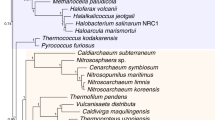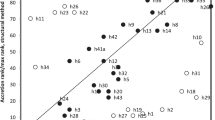Abstract
The origin of the eukaryotic nucleus is difficult to reconstruct. Eukaryotic organelles (chloroplast, mitochondrion) are eii bacterial1,2 endosymbionts3,but the source of nuclear genes has been obscured by multiple nucleotide substitutions. Using evolutionary parsimony4, a newly developed rate-invariant treeing algorithm, the eukaryotic ribosomal rRNA genes are shown to have evolved from the eocytes5, a group of extremely thermophilic, sulphur-metabolizing, anucleate cells. The deepest bifurcation yet found separates the reconstructed tree into two taxonomic divisions. These are a proto-eukaryotic group (karyotes) and an essentially bacterial one (parkaryotes). Within the precision of the rooting procedure, the tree is not consistent with either the prokaryotic–eukaryotic or the archaebacterial–eubacterial–eukaryotic groupings. It implies that the last common ancestor of extant life, and the early ancestors of eukaryotes, probably lacked nuclei, metabolized sulphur and lived at near-boiling temperatures.
This is a preview of subscription content, access via your institution
Access options
Subscribe to this journal
Receive 51 print issues and online access
$199.00 per year
only $3.90 per issue
Buy this article
- Purchase on Springer Link
- Instant access to full article PDF
Prices may be subject to local taxes which are calculated during checkout
Similar content being viewed by others
References
Schwartz, Z. & Kossel, H. Nature 238, 739–772 (1980).
Spencer, D. F., Schnare, M. N. & Gray, M. W. Proc. natn. Acad. Sci. U.S.A. 81, 493–497 (1984).
Margulis, L. Symbiosis in Cell Evolution (Freeman, San Francisco, 1981).
Lake, J. A. Molec. biol. Evol. 4, 167 (1987).
Lake, J. A., Hendersen, E., Oakes, M. & Clark, M. W. Proc. natn. Acad. Sci. U.S.A. 81, 3786–3790 (1984).
Felsenstein, J. Syst. Zool. 27, 401–410 (1978).
Li, W. H., Wolfe, K. H., Sourdis, J. & Sharp, P. M. Symp. Quant. Biol. 52 (in the press).
Pace, N. R., Stahl, D. A., Lane, D. J. & Olsen, G. J. Adv. microbiol. Ecol. 1–55 (1986).
Erdmann, V. A. et al. in Endocytobiology III (eds J. J. Lee & J. F. Frederick) (New York Academy of Sciences, 1987).
Lake, J. A. Nature 319, 626 (1986).
Penny, D. & Hendy, M. D. Cladistics 1(3), 266–278 (1981).
Hickson, J. E. & Brown, W. M. Molec. biol. Evol. 3, 1–18 (1986).
Fitch, W. M. J. molec. Evol. 18, 30–37 (1981).
Fitch, W. Am. Nat. 111, 223–257 (1977).
Brown, W. M., Prager, E. M., Wang, A. & Wilson, A. C. J. molec. Evol. 18, 225–239 (1982).
Eldridge, N. & Cracraft, J. Phylogenetic Patterns and the Evolutionary Process (Columbia University Press, New York, 1980).
Fox, G. E. et al. Science 209, 457–463 (1980).
Larsen, N., Leffers, H., Kjems, J. & Garrett, R. A. System. Appl. Microbiol. 7, 49–57 (1986).
Zillig, W., Schnabel, R. & Stetter, K. O. Curr. Top. Microbiol. Immun. 33, 1–18 (1985).
Wiley, E. O. Phylogenetics (Wiley, New York, 1981).
Mayr, E. Principles of Systematic Zoology (McGraw-Hill, New York, 1969).
Stetter, K. O. & Gaag, G. Nature 305, 309–311 (1983).
Schopf, J. W. Earth's Earliest Biosphere (Princeton University Press, New Jersey, 1983).
Findlay, J. B. C. & Pappin, D. J. C. Biochem. J. 238, 625–642 (1986).
Lake, J. A. Nature 321, 657–658 (1986).
Lake, J. A. J. molec. Evol. 26, 59–73 (1987).
Wilson, A., Carlson, S. & White, T. A. Rev. Biochem. 46, 573–639 (1977).
Huysmans, E. & DeWachter, R. Nucleic Acids Res. 14, 73–118 (1986).
McCarroll, R., Olsen, G. J., Stahl, Y. D., Woese, C. R. & Soglin, M. S. Biochemistry 22, 5858–5868 (1983).
Leinfelder, W., Jarsch, M. & Bock, A. System Appl. Microbiol. 6, 164–170 (1985).
Allsopp, A. New Phytol. 68, 591–612 (1969).
Author information
Authors and Affiliations
Rights and permissions
About this article
Cite this article
Lake, J. Origin of the eukaryotic nucleus determined by rate-invariant analysis of rRNA sequences. Nature 331, 184–186 (1988). https://doi.org/10.1038/331184a0
Received:
Accepted:
Published:
Issue Date:
DOI: https://doi.org/10.1038/331184a0
This article is cited by
-
The chromatin landscape of the euryarchaeon Haloferax volcanii
Genome Biology (2023)
-
Diversity, metabolism and cultivation of archaea in mangrove ecosystems
Marine Life Science & Technology (2021)
-
Division of labour in a matrix, rather than phagocytosis or endosymbiosis, as a route for the origin of eukaryotic cells
Biology Direct (2020)
-
Perspectives on Cultivation Strategies of Archaea
Microbial Ecology (2020)
-
The trickster microbes that are shaking up the tree of life
Nature (2019)
Comments
By submitting a comment you agree to abide by our Terms and Community Guidelines. If you find something abusive or that does not comply with our terms or guidelines please flag it as inappropriate.



